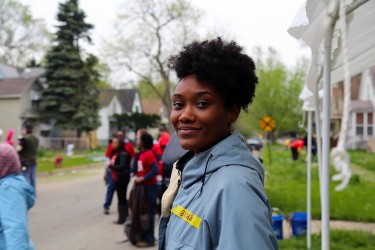NEIGHBORHOOD SELECTION
While we were still developing our system, we began by examining what makes a family, and community, succeed. So, we pulled data from past Habitat projects and family experiences in Chicago to identify success trends, and then deployed a team of volunteer planners to dive into the research surrounding healthy neighborhood factors. We also examined the models and criteria of other successful community development and civic organizations, and after some trial and error, nailed down an investment theory and process for finding the neighborhoods that have the best potential to benefit from what we have to offer.
High Potential Neighborhoods
As a theory of investment, we focus on middle-market neighborhoods, which can typically be identified by:
-
Having some developing or current assets.
-
Having some level of existing community cohesion that provides value to residents.
-
Being at risk of decline due to flat real-estate markets and long-term or recent disinvestments in residential and commercial properties.
The decline risk in these neighborhoods is significant but, with small, targeted and immediate improvements, can be stabilized, creating exponential benefits to residents. Unfortunately, these neighborhoods don’t always receive much attention as they are not strong enough to attract new homebuyers and commercial prospects and not weak enough to land on the radars of many funders or development organizations.
But it is these exact conditions, viewed through the lens of our core programmatic strengths, that have us seeing only potential. Our programs create a demand for real estate through home purchases; improve the perception of the neighborhood through physical beautification; and strengthen social cohesion through volunteerism and neighborhood groups – a collection of outcomes that, if executed in sufficient volume, equates to a significant market intervention in this type of neighborhood. And if we can initiate an intervention strategy in a middle-market neighborhood while its decline is slow, the direct costs will be relatively low compared to the high costs, both financially and socially, of intervention after the crushing domino effects of disinvestment.
Neighborhood Evaluation Strategy
For neighborhood selection, we use a two-part evaluation process that uses both hard and soft data points to paint a complete picture of a potential area. First, we collect data and map it, including demographics, assets, connectivity, real estate status and trends, economic considerations and investments. Then we work on gaining a better understanding of the community on a personal level. This step involves in-person conversations with multiple stakeholders in the potential neighborhood to hone in on community organization, interest level, need level, and potential partnerships for completing the work.
Taking this data, we use a prioritized set of factors, derived from past experiences with homeowners, trends in community development and middle-market parameters, to compare areas. These factors include:
-
Presence of good or fair quality schools (elementary and high school)
-
Level of employment and access to jobs
-
Level of safety and crime index
-
Presence and quality of amenities (community centers, parks, groceries)
-
Active and organized community (faith organizations, non-profits, block clubs)
-
Homeownership rate
-
Transportation access
-
Market trends and property values
Our staff and volunteer committee work together over several months, and after weighing all factors, make a recommendation to the board.
However, we do also realize that neighborhoods can change, and just because they weren't a good fit during an initial assessment, doesn't mean they won't be a good fit in the future.
Entry
After selection approval, it can be a lengthy process to actually begin physical projects due to:
-
Developing collaborative relationships with current residents and community leaders.
-
The need for additional research and the creation of targeted, neighborhood-specific investment strategies.
-
The slow process of land acquisition that often involves working with several parties.
Though the neighborhood selection process is lengthy, it’s the most responsible thing we can do for our program participants, volunteers and donors who trust us to make a difference for the people in the neighborhoods in which we work. When we commit to a focus neighborhood, we are committing to a large multi-year investment focused on long-term outcomes and improved quality of life. Having a systematic, data-backed process that lets us start on the right footing only improves the chances of success.
